When choosing a new fitness tracker, the decision often boils down to one key contest: Fitbit vs Apple Watch. The two mammoth brands have been at the top of the tracker game for years and, though the likes of Garmin and Whoop also boast some of the best fitness trackers (opens in new tab) on the market, the pair remain two of the biggest names in the wearable space.
But, with Black Friday Apple and Fitbit sales in full swing, and people looking to upgrade, which one should you pick to take pride of place on your wrist? Unfortunately, there’s no simple answer to that question. Instead, you have to consider your health and fitness goals, what you plan to use the tracker for, and the metrics you value most to determine which brand wins.
Not only this, but you’ve also got to pick which Fitbit or Apple Watch you want, with different models and generations offering varying degrees of detail in their health and fitness feedback (not to mention catering to a range of budgets).
To help you make your mind up, we’ve considered the features, workout-tracking credentials, design and battery life of the Fitbit and Apple Watch models available to deliver a final verdict on which one wins this high-tech battle royal. So, read on to find out which brand is right for you. Or, if you’re still looking for a new fitness companion, have a scroll through our round-up of the best Black Friday fitness deals for 2022.
Black Friday deals
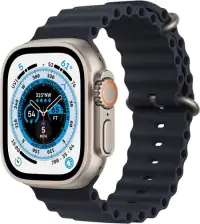 (opens in new tab)
(opens in new tab)Apple Watch Ultra Was: $799 Now: $739 at Best Buy (opens in new tab)
The Apple Watch Ultra has been dubbed the brand’s “most rugged and capable” watch ever, and its price certainly reflects that. But, this Black Friday, you can save $60 on one of these wearables at Walmart. The Ultra is bigger (49mm) and brighter than other Apple Watches, offering improved battery life, better water resistance and a titanium case that makes it a good fit for adventurous wearers.
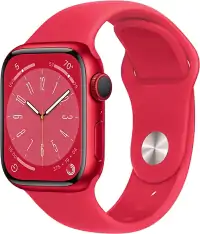 (opens in new tab)
(opens in new tab)Apple Watch Series 8 Was: $399 Now: $349 on Amazon (opens in new tab)
Despite only being two months old, the Apple Watch 8 has already been discounted on Amazon, now available with a $50 saving. You’ll get the impressive health-tracking features of its predecessor, including blood oxygen sensors and the usual step-counting, along with a new sensor that measures your temperature over time and provides cycle-tracking using the data collected.
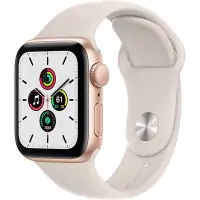 (opens in new tab)
(opens in new tab)Apple Watch SE 1st Gen Was: $279 Now: $149 at Walmart (opens in new tab)
The sleek Apple Watch SE is no almost half-price at Walmart this Black Friday. It has a wealth of health and fitness tracking capabilities, monitoring your exercise and everyday activity levels, while also allowing you to sync your music, podcasts and audiobooks for easy on-the-go listening.
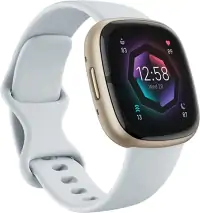 (opens in new tab)
(opens in new tab)Fitbit Sense 2 Was: $299.95 Now: $199.95 on Amazon (opens in new tab)
The Fitbit Sense 2 offers a whole host of health-monitoring capabilities, from mapping your stress levels to measuring your sleep quality – it will even give you advice to help improve on your results. And, thanks to Amazon, it’s now dropped to a record-equalling low price of under $200.
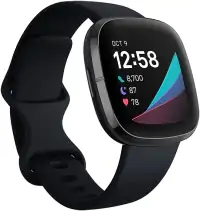 (opens in new tab)
(opens in new tab)Fitbit Sense Was: $249.95 Now: $139.95 at Best Buy (opens in new tab)
The Sense 2 is a fantastic wearable, but if you want to save some money then the original Fitbit Sense is still a fantastic option, with advanced health metrics and a handy daily readiness score that will tell you whether you should push your training or take a rest day. It’s now $60 cheaper than its younger sibling thanks to a Best Buy Black Friday deal.
What models are available?
There’s a huge range of Fitbit fitness trackers and smartwatches available, from the sports-focused Fitbit Charge 5 to the all-singing Fitbit Sense. In contrast, Apple has just four models – the 3, SE, 6 and the new Apple Watch Series 7.
While all of the models in Apple's range have the same squarish, chunky look, you'll find more variety among Fitbit's catalogue of models. Some, like the Charge 5 above, are thin, discreet bands, while others like the Sense have larger, square-shaped clock faces more reminiscent of the Apple Watch.
Wearable analyst Leo Gebbie from Connected Devices told Live Science that, historically, Fitbit and Apple targeted different areas of the fitness industry.
"The Apple Watch was positioned as an exclusive premium-tier device offering a powerful user interface and third-party app support, whereas Fitbit offered a range of more affordable fitness trackers and smartwatches backed up by a well-established brand," he said.
"However, Apple has diversified its offering over time, bringing older models of the Watch down the price curve to compete directly with Fitbit smartwatches. The Series 3 is the entry-level Apple Watch which is available at $199, half the price of its flagship model."
One of the main differences between Fitbit and Apple Watch is the latter’s close optimization with the rest of the Apple ecosystem. You need an iPhone to activate the Watch, and it is integrated with Apple’s other devices and services to provide an excellent user experience. By contrast, Fitbit devices are compatible with all smartphones, and simply require the Fitbit smartphone app for connection, making them easily accessible.
It's also worth pointing out that Fitbit models are a lot cheaper — some of the best budget fitness trackers (opens in new tab) are Fitbit designs. Apple's wearables tend to be pricier.
Which has more smartwatch features?
This one is a win for Apple, which boasts more smart features than its fitness tracking companion.
An Apple Watch offers notifications, alarms, timers, Siri and a huge app store. By contrast, Fitbit has some basic services like notification mirroring, and a smaller app offering. You can use your Watch to make payments through Apple Pay, while only a handful of the Fitbit models allow payment via Fitbit Pay.
Apple Watch even has some models with Cellular capabilities, meaning you can accept calls and texts from your wrist, without your iPhone.
The companies also have slightly different approaches to music: with Apple, you can download albums on your watch from the likes of Apple Music and Spotify. On Fitbit, the only way you can download music is if you do so via Deezer or Pandora.
It's not a huge issue if you prefer to store music on your phone, but it does give Apple the edge in this category.
Which is better for tracking workouts?
Both Fitbit and Apple Watch can track workouts. However, depending on the actual device you're using, they will do this in very different ways, says Gebbie.
"For example, any device from either company can detect when a user is active and record metrics like heart rate and calories burned to review afterwards. But when it comes to specific forms of exercise, there are some differences.
"If you want to go for a run, you’ll be best served by a wearable with GPS on board to get the most accurate tracking of your movement. All Apple Watches include this, whereas not all Fitbits do."
Owning an Apple Watch allows access to Fitness+ (opens in new tab), hundreds of instructor-led home workouts including HIIT sessions, yoga and spinning on your iPhone, ipad and Apple TV (but this requires an extra subscription).
You can get workout classes from Fitbit too, but only if you subscribe to Fitbit Premium.
Which one has more features?
The Apple Watch and Fitbit models are packed with health and fitness features to monitor heart rate, steps, calories burned, sleep and workouts.
All Apple Watches have inbuilt GPS, while only some Fitbits do. Similarly, some (but not all) Fitbit models and Apple Watches have blood oxygen tracking capabilities. The higher-end Fitbits with GPS and the Apple Watch Series 7 both do, while the SE and 3 Watch don’t. Both the Fitbit Sense and the Apple Watch 7 have ECG readings, allowing you to monitor heart health.
Gebbie also highlights that "the top-of-the-range Fitbit Sense smartwatch packs some new sensors, which are less common across the wearables landscape, such as an electrodermal activity (EDA) sensor which analyses a wearer’s sweat levels to check for signs of stress."
Both brands offer motivational prompts in different forms. Below, you can see the Apple Ring system, which encourages you to move about during the day, while Fitbit has an Active Zone Minutes scheme (which recommends 150 minutes per week spent in your targeted heart rate zone).
You can also use your Fitbit or Apple Watch to help with your mental health. The Apple Watch has an inbuilt breathe app, while the Fitbit Sense has a electrodermal (EDA) sensor to track how stressed out you are. This works by measuring the perspiration of your hands, which can be a marker for stress. The Fitbit app also has meditation tools included.
One of our favorite features on Apple Watch is if you start a workout but forget to log it, you will get a prompt asking if you want to turn on tracking.
Even more impressive, the new Apple 7 uses specialist AI software to recognize the type of movement you’re doing. For example, rather than simply track that you are dancing, it can distinguish that you are Bhangra dancing – and give a more accurate calorie count as a result.
Which design is better?
With its square design, the Apple Watch has hardly changed since it launched in 2015. The series 7 has the biggest and toughest screen to date (41mm x 45mm).
The Fitbit started out as an activity band-type design and a lot of its models still stick with this aesthetic. The Inspire 2, Charge 5 and Luxe models are all slim trackers, while the Versa 3 and the Sense have a larger, square face.
Both Apple Watches and Fitbits are swim proof and can be personalized by changing bands or watch faces.
Which look you prefer is down to you, although in our experience the slimmer designs are easier to wear during the night, so they might be preferable for sleep tracking.
Which has better battery life?
When it comes to battery life, Fitbit wins hands down, said Gebbie. "The Apple Watch offers an 18-hour battery life, which means you need to charge it every day, whereas many Fitbit trackers and watches can last for days or even weeks at a time without charging.
"This simplicity and reliability is attractive to a lot of users, and our research at Connected Devices has always found that battery life is hugely important to customers.
"However, the Apple Watch offers a more polished user experience than even top-end Fitbit smartwatches, with a more advanced operating system and a wider suite of services.
"This means that the Watch is something of a Swiss Army Knife and is intended to reduce wearers’ reliance on their smartphones by offering a powerful experience on the wrist."
The Verdict
The question of which device is better, Fitbit vs Apple Watch, really boils down to what you want from your wearable.
"People who want to spend less money and have a straightforward tracker for their fitness and health will be better served with a Fitbit fitness tracker, whereas those who want a premium smartwatch that can do it all should look at the Apple Watch – as long as you own an iPhone," said Gebbie.
But, with a spectrum of offerings from both companies, it’s a case of matching up the features and sensors that you want with the price you are willing to pay.









